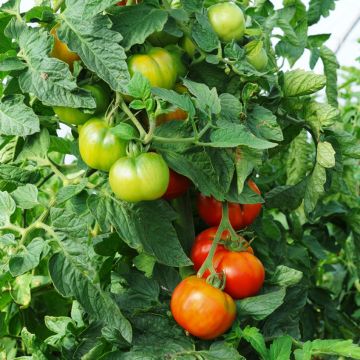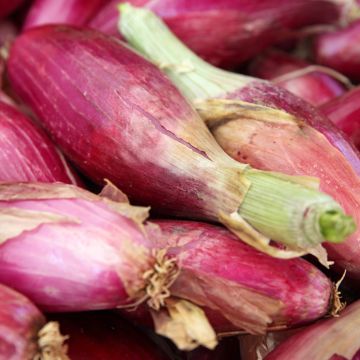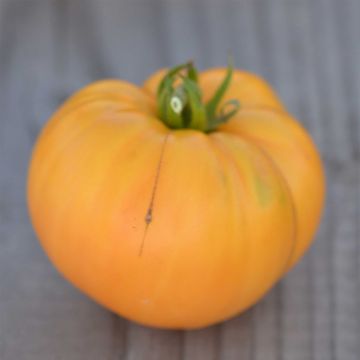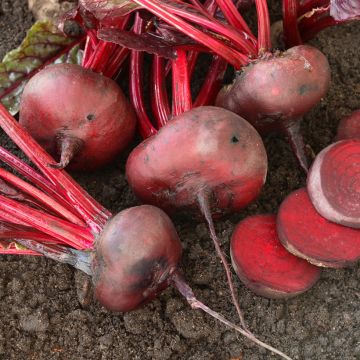

Tomatillo du Mexique Purple Xtrem
Mexican Tomatillo Purple Xtrem
Physalis ixocarpa Purple Xtrem
Tomatillo, Mexican husk tomato, Large-flowered tomatillo
Special offer!
Receive a €20 voucher for any order over €90 (excluding delivery costs, credit notes, and plastic-free options)!
1- Add your favorite plants to your cart.
2- Once you have reached €90, confirm your order (you can even choose the delivery date!).
3- As soon as your order is shipped, you will receive an email containing your voucher code, valid for 3 months (90 days).
Your voucher is unique and can only be used once, for any order with a minimum value of €20, excluding delivery costs.
Can be combined with other current offers, non-divisible and non-refundable.
Why not try an alternative variety in stock?
View all →This plant carries a 6 months recovery warranty
More information
We guarantee the quality of our plants for a full growing cycle, and will replace at our expense any plant that fails to recover under normal climatic and planting conditions.
Description
The Purple Xtrem Mexican Tomatillo is a very pretty dark purple variety, with a fruit that is 3 to 5cm (1 to 2in) wide and nestled in a light green calyx, creating a contrast. When eaten raw, the fruit has a rather spicy flavor and is used in salsa verde. When cooked, the tomatillo's flavour becomes more acidic and reminiscent of lemons. Tomatillos are named as such because they have a formal resemblance to tomatoes. They are actually fruits from the Physalis family. These small fruits are widely used in Mexican cuisine, but also in South American culinary traditions in general. This Purple Xtrem Mexican Tomatillo proves once again that a vegetable garden can be both nourishing and aesthetically pleasing. This fruit is sown in April and harvested from August to October.
The Mexican Tomatillo is a perennial vegetable plant cultivated as an annual, closely related to both tomatoes and Physalis. It produces greenish fruits covered by a calyx.
They prefer well-fertilised soil, warm and well-exposed conditions. Growing them under cover is recommended in cooler climates. You can choose to stake them like tomatoes or let them crawl on the ground. Their height or spread, depending on the growing method, is about one metre.
Take note: Tomatillo flowers are self-sterile so you will need at least two plants to obtain fruit.
Harvest: harvests take place from late summer to autumn: pick the ripe fruit when the calyx is dry.
Storage: they can be stored for a few days in a cool place.
Gardener's tip: in regions with very mild winters, you can protect the plants' roots and keep your Tomatillos from year to year. Consider using dead leaves as they provide effective and cost-efficient protection.
Report an error about the product description
Harvest
Plant habit
Foliage
Botanical data
Physalis
ixocarpa
Purple Xtrem
Solanaceae
Tomatillo, Mexican husk tomato, Large-flowered tomatillo
South America
Annual
Other Vegetable seeds from A to Z
View all →Planting and care
Tomatillos are easy to cultivate, following the same process as tomatoes. Sunlight and warmth are crucial for a successful crop. They can grow in any type of soil, although they prefer rich, loose, and well-draining soil. If the substrate is too compact, you can add some sand to improve it.
Sowing: From mid-February to May, sow your seeds indoors or in a heated greenhouse in trays at around 20°C (68°F). Bury the seeds about 5 to 7mm deep in "special sowing" compost, as they need darkness to germinate. Do not use compost at this stage, as it may burn the future roots. The growth is rapid: the seeds will sprout between 3 days and a week after sowing. When the plants have reached 5 to 6 true leaves, transplant them into buckets that provide a little more space for their roots and start acclimatising them to the outside on sunny days.
Transplanting into open ground: Once the risk of frost has passed, usually after mid-May, transplant your plants into open ground. Choose the sunniest and warmest spots in the garden. The base of a south-facing wall is an ideal position. Loosen the soil and dig a hole at least 3 to 4 times the volume of the plant's root system. Add some well-decomposed compost at the bottom. Place your plant, firm the soil, create a basin around the base, and water thoroughly. Avoid watering the leaves to protect your plants from fungal diseases. If you plan to plant multiple plants, space them 60 cm (24in) apart in all directions.
Maintenance: Applying mulch around the base of your plants helps retain some moisture and reduces the need for weeding. The plants do not require excessive watering as their root system has a taproot that searches deep for available resources. Water generously only during prolonged periods of drought.
Seedlings
Care
Intended location
This item has not been reviewed yet - be the first to leave a review about it.
Similar products
Haven't found what you were looking for?
Hardiness is the lowest winter temperature a plant can endure without suffering serious damage or even dying. However, hardiness is affected by location (a sheltered area, such as a patio), protection (winter cover) and soil type (hardiness is improved by well-drained soil).

Photo Sharing Terms & Conditions
In order to encourage gardeners to interact and share their experiences, Promesse de fleurs offers various media enabling content to be uploaded onto its Site - in particular via the ‘Photo sharing’ module.
The User agrees to refrain from:
- Posting any content that is illegal, prejudicial, insulting, racist, inciteful to hatred, revisionist, contrary to public decency, that infringes on privacy or on the privacy rights of third parties, in particular the publicity rights of persons and goods, intellectual property rights, or the right to privacy.
- Submitting content on behalf of a third party;
- Impersonate the identity of a third party and/or publish any personal information about a third party;
In general, the User undertakes to refrain from any unethical behaviour.
All Content (in particular text, comments, files, images, photos, videos, creative works, etc.), which may be subject to property or intellectual property rights, image or other private rights, shall remain the property of the User, subject to the limited rights granted by the terms of the licence granted by Promesse de fleurs as stated below. Users are at liberty to publish or not to publish such Content on the Site, notably via the ‘Photo Sharing’ facility, and accept that this Content shall be made public and freely accessible, notably on the Internet.
Users further acknowledge, undertake to have ,and guarantee that they hold all necessary rights and permissions to publish such material on the Site, in particular with regard to the legislation in force pertaining to any privacy, property, intellectual property, image, or contractual rights, or rights of any other nature. By publishing such Content on the Site, Users acknowledge accepting full liability as publishers of the Content within the meaning of the law, and grant Promesse de fleurs, free of charge, an inclusive, worldwide licence for the said Content for the entire duration of its publication, including all reproduction, representation, up/downloading, displaying, performing, transmission, and storage rights.
Users also grant permission for their name to be linked to the Content and accept that this link may not always be made available.
By engaging in posting material, Users consent to their Content becoming automatically accessible on the Internet, in particular on other sites and/or blogs and/or web pages of the Promesse de fleurs site, including in particular social pages and the Promesse de fleurs catalogue.
Users may secure the removal of entrusted content free of charge by issuing a simple request via our contact form.
The flowering period indicated on our website applies to countries and regions located in USDA zone 8 (France, the United Kingdom, Ireland, the Netherlands, etc.)
It will vary according to where you live:
- In zones 9 to 10 (Italy, Spain, Greece, etc.), flowering will occur about 2 to 4 weeks earlier.
- In zones 6 to 7 (Germany, Poland, Slovenia, and lower mountainous regions), flowering will be delayed by 2 to 3 weeks.
- In zone 5 (Central Europe, Scandinavia), blooming will be delayed by 3 to 5 weeks.
In temperate climates, pruning of spring-flowering shrubs (forsythia, spireas, etc.) should be done just after flowering.
Pruning of summer-flowering shrubs (Indian Lilac, Perovskia, etc.) can be done in winter or spring.
In cold regions as well as with frost-sensitive plants, avoid pruning too early when severe frosts may still occur.
The planting period indicated on our website applies to countries and regions located in USDA zone 8 (France, United Kingdom, Ireland, Netherlands).
It will vary according to where you live:
- In Mediterranean zones (Marseille, Madrid, Milan, etc.), autumn and winter are the best planting periods.
- In continental zones (Strasbourg, Munich, Vienna, etc.), delay planting by 2 to 3 weeks in spring and bring it forward by 2 to 4 weeks in autumn.
- In mountainous regions (the Alps, Pyrenees, Carpathians, etc.), it is best to plant in late spring (May-June) or late summer (August-September).
The harvesting period indicated on our website applies to countries and regions in USDA zone 8 (France, England, Ireland, the Netherlands).
In colder areas (Scandinavia, Poland, Austria...) fruit and vegetable harvests are likely to be delayed by 3-4 weeks.
In warmer areas (Italy, Spain, Greece, etc.), harvesting will probably take place earlier, depending on weather conditions.
The sowing periods indicated on our website apply to countries and regions within USDA Zone 8 (France, UK, Ireland, Netherlands).
In colder areas (Scandinavia, Poland, Austria...), delay any outdoor sowing by 3-4 weeks, or sow under glass.
In warmer climes (Italy, Spain, Greece, etc.), bring outdoor sowing forward by a few weeks.





























































